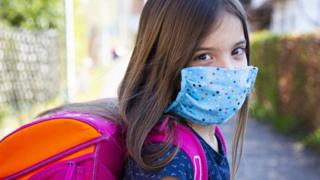 Image copyright
Getty Images
Image copyright
Getty Images
Current testing and contact tracing is inadequate to prevent a second wave of coronavirus after schools in the UK reopen, scientists have warned.
Increased transmission would also result from parents not having to stay at home with their children, they say.
Researchers said getting pupils back to school was important - but more work was needed to keep the virus in check.
The government said plans were in place to ensure schools can reopen safely at the start of the new school year.
Asked about the estimate that only 50% of contacts are being traced in an interview with BBC Breakfast, Simon Clarke, minister for regional growth, said government figures were higher.
He said NHS Test and Trace is "maturing all the time" and getting children back to school in the autumn is a "top priority" that the government would not "be willing to trade".
"You're building an entirely new infrastructure which there's no precedent for," he said.
"But we're confident it is working, we're confident that it will continue to improve, and we're confident that it will allow schools to open safely in the autumn."
A government statement said local authorities will "be able to determine the best action to take to help curb the spread of the virus should there be a rise in cases".
Researchers from UCL and the London School of Hygiene and Tropical Medicine used computer models to see how the virus might spread in the UK as pupils returned to the classroom and their parents were more able to go back to work or resume other activities.
The study assumes children are less likely to catch - and therefore spread - coronavirus and that some parents would continue to work from home.
As first reported in June, the combined effect on pupils and parents would be enough to cause a second wave if there was no effective test-and-trace programme.
This would happen around December 2020 and would be twice as big as the first peak, unless the government took other actions such as reimposing lockdown.
The study, now formally published in the Lancet Child and Adolescent Health, shows a second wave could be prevented if:
both 75% of people with Covid symptoms were found and 68% of their contacts traced or both 87% of people with symptoms were found and 40% of their contacts tracedHowever, the researchers said NHS Test and Trace in England was currently falling short.
They estimate only 50% of contacts are being traced and while it is harder to know the percentage of people being tested, they say this also appears too low.
"It is not achieving the levels we have modelled. It doesn't look good enough to me," said Prof Chris Bonell, from the London School of Hygiene and Tropical Medicine.
Dr Jasmina Panovska-Griffiths, from UCL, added: "With UK schools reopening fully in September, prevention of a second wave will require a major scale-up of testing to test 75% of symptomatic infections - combined with tracing of 68% of their contacts, and isolation of symptomatic and diagnosed cases."
How test-and-trace works:
People with symptoms of cough, fever or loss of sense of smell or taste are tested If they are positive for coronavirus, they isolate for 10 days and their household does so for 14 days They have to inform the NHS of everyone they have come into close contact with These contacts must also spend 14 days in quarantineSchools have been shut around the world as countries used lockdowns to control the spread of Covid-19. It is estimated 1.6 billion children have been kept out of the classroom.
In the UK, schools closed on 20 March, except to children of key workers or vulnerable children. On 1 June, they began a limited reopening for early years pupils, Reception, Year 1 and Year 6.
Schools are due to restart for all children in Scotland on 11 August and across the UK in early September.
But every step taken to open up society makes it easier for the coronavirus to spread.
Cases are already starting to rise and the idea of closing pubs in order to open schools has already been floated.
The UK government's chief medical adviser, Prof Chris Whitty, says "we are near the limit" of what we can do without causing a resurgence.
The individual nations of the UK have their own contact tracing systems.
The Welsh government said its advisory group recommended that schools open in September with 100% of pupils present on site, and "we should be aiming to trace an estimated 80% of contacts, at least 35% of which are to be traced within 24 hours".
Since 21 June, 90% of close contacts were reached by the service, according to figures from the Welsh government.
A Scottish government said that ensuring a "safe environment" for education was its "absolute priority" and guidance set out "a number of specific risk-mitigation measures that will need to be introduced" including an "enhanced surveillance programme".
In Northern Ireland, the latest figures for the week to 29 July showed 98% of contacts were successfully reached by the country's contact tracing service.
Follow James on Twitter

 5 years ago
591
5 years ago
591 

